Autonomous AI Agents
Empowering Generative AI for Next Generation of Human Assistant
Autonomous AI agents, developed since the 1980s, can interact with their environment, perceive data, and take actions towards specific goals by computers. They simulate intelligent behavior, ranging from simple rule-based systems to complex machine learning models. Autonomous AI Agents operate independently, making decisions based on internal systems, and are used across industries for improved efficiency and adaptability. Autonomous AI agents can adapt to new circumstances, learn from their experiences, and make decisions utilizing their internal systems.
Remarkably, in August 2023, HyperWrite, a startup introduced an experimental agent with the ability to navigate the web and interact with websites in a manner resembling human users. During a private Zoom demonstration, HyperWrite's CEO, Matt Shumer, showcased to VentureBeat how the agent, accessible via the company's Chrome extension, could visit the Domino's Pizza website and initiate an order. The agent successfully searched for an address and zip code to complete the transaction.
Experimental Autonomous AI Agent systems that run on large language models (LLM) such as GPT4 are attracting billions of dollars of investment to compete with the advances in Autonomous AI in 2023.
In September 2023, Imbue (formerly known as Generally Intelligent), raised $200 million in a Series B funding round. Investors in this round included Astera Institute, NVIDIA, Kyle Vogt, and Simon Last. Imbue has raised a total of $220M in capital throughout 4 funding rounds, with a current valuation of $1B.
In late June 2023, Inflection AI, a startup, secured $1.3 billion in funding. The company is focused on developing a personal assistant. Co-founders Reid Hoffman and Mustafa Suleyman discussed these capabilities in a podcast.
In March 2023, HyperWrite secured $2.80 million in a Seed VC round, with notable investors including Active Capital, Cortical Ventures, Madrona Venture Group, Aidan Gomez, and Furqan Rydhan, among others. HyperWrite has successfully raised a total of $5.40 million in capital through two funding rounds. The company currently holds a valuation of $11.77 million.
In March 2023, Adept secured $350 million in Series B round, with notable investors including General Catalyst, Spark Capital, Greylock Partners, Addition, and A.Capital, among others. Adept has raised a total of $415M in funding through 2 funding rounds. Its valuation after the last round stood at $1B.
The Understanding and Evolution of Autonomous AI Agents
Definition
Autonomous AI Agents refer to AI systems or agents that can perceive the environment, make decisions and execute actions. Autonomous AI Agents utilize the capabilities of artificial intelligence to their fullest extent, enabling quicker and more efficient responses in tasks such as object detection, behavior analytics, autonomous tracking, and scalable event responses. It coordinates diverse tasks across various AI algorithms, enabling it to execute and complete assignments in time-sensitive scenarios. In contrast, conventional artificial intelligence systems operate by processing large volumes of labeled data to identify, organize, and generate specific outcomes, such as correlations, patterns, predictions, or automated responses.
A Brief History of Generative AI and Autonomous AI Agents
The development of AI and NLP has seen significant milestones and breakthroughs over the years. The Turing test proposed the idea that machines can think, leading to the establishment of intelligence machines. The introduction of the Hopfield network laid the foundation for recurrent neural networks (RNN), while the concept of Agents brought social interaction and intelligence into the field of AI. The convolutional neural network revolutionized image processing, and the Word2Vec model transformed NLP with word embeddings. The Transformer architecture, introduced in 2017, became the basis for large language models (LLM) such as GPT. GPT-2 and GPT-3, released by OpenAI, demonstrated remarkable language generation capabilities. GPT-4, released in March 2023, showcased improved reliability, creativity, and nuanced instruction handling compared to its predecessor. The development of large language models lays a foundation for Autonomous AI Agents, as shown in Table 1.
Table 1. The milestone of Generative AI and Autonomous AI Agents
| Time | Milestone |
|---|---|
| 1950 | The Turing test is proposed, suggesting the possibility of machines thinking and the establishment of intelligence machines. |
| 1982 | Hopfield introduced the Hopfield network, marking the beginning of recurrent neural networks (RNNs) with memory storage capabilities. |
| 1986 | Minsky introduced the concept of Agents in his book "The Society of Mind," emphasizing collective problem-solving and social interaction. |
| 1989 | Yann LeCun introduced the convolutional neural network (CNN), revolutionizing image processing in computer vision. |
| 2013 | Mikolov and colleagues introduced the Word2Vec model, revolutionizing NLP with word embeddings and capturing semantic relationships effectively. |
| 2017 | Vaswani and colleagues introduce the Transformer architecture, utilizing self-attention mechanisms and enabling parallel processing of sequences. |
| 2018 | Devlin and his team at Google introduce BERT (Bidirectional Encoder Representations from Transformers), achieving state-of-the-art performance in NLP tasks. |
| 2019 | GPT-2 is introduced, showcasing enhanced capabilities but raising concerns about potential misuse. |
| 2020 | GPT-3 is released, representing a significant leap in size and performance with 175 billion parameters and exceptional language understanding and generation abilities. |
| March 2023 | GPT-4 is unveiled, demonstrating improved reliability, creativity, and nuanced instruction handling compared to its predecessor. |
| June 2023 | Lilian Weng, a researcher from the OpenAI published LLM Powered Autonomous AI Agents, outlining that Building agents with LLM (large language model) as its core controller is a cool concept, in which demonstrating the concepts of Autonomous AI Agents. |
The Concept of Autonomous AI Agents
Autonomous AI Agent Models
As shown in figure 1, agents perceive their environment, a core agent component is the memory stream, a database that stores a comprehensive record of experience. Based on these perceptions, the architecture retrieves relevant memories and then uses those retrieved actions to determine an action. Based on Lilian Wang’s recent framework, in an Autonomous AI Agent system powered by a Large Language Model (LLM), the LLM serves as the agent's central processing unit, supported by three important components:
Planning
Subgoal and decomposition: The agent breaks down complex tasks into smaller, more manageable subgoals, allowing for efficient handling of intricate tasks.
Reflection and refinement: The agent engages in self-evaluation and introspection of past actions, learning from mistakes and refining its approach for future steps, thereby enhancing the quality of the final results.
Memory
Short-term memory: All the learning that occurs within a specific context (referred to as Prompt Engineering) as utilizing the model's short-term memory to learn and adapt.
Long-term memory: This enables the agent to retain and recall a vast amount of information over extended periods. It often relies on an external vector store and efficient retrieval mechanisms.
Tool use
The agent learns to utilize external Application Programming Interfaces (APIs) to access additional information that may not be present in the model's pre-trained weights. This includes real-time data, code execution capabilities, access to proprietary information sources, and more. This allows the agent to augment its knowledge and capabilities beyond its initial training.
Figure 1. Overview of an LLM-powered Autonomous AI Agent system
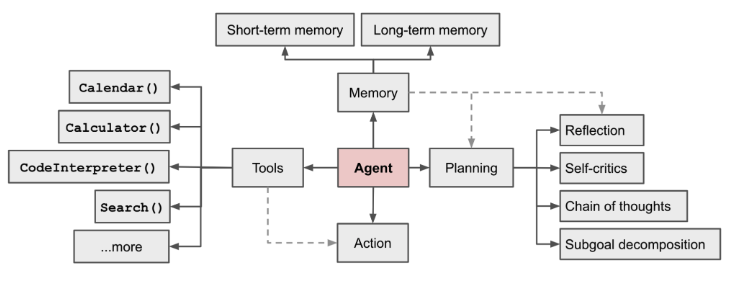 Source: “LLM Powered Autonomous Agents”
Source: “LLM Powered Autonomous Agents”
Autonomous AI Agents receive input from users and break down into smaller tasks with the help of large language models such as GPT-4. By employing a seamless integration of reasoning and tool selection prompt patterns in an infinite loop, these agents are capable of executing potentially limitless, iterative tasks. Figure 2 demonstrates the logic of GPT-based autonomous tasks response. The agent works by perceiving the environment, processing information, and breaking down into smaller tasks to meet specific goals. The process usually involves the following steps.
Figure 2. GPT-4 based autonomous tasks response
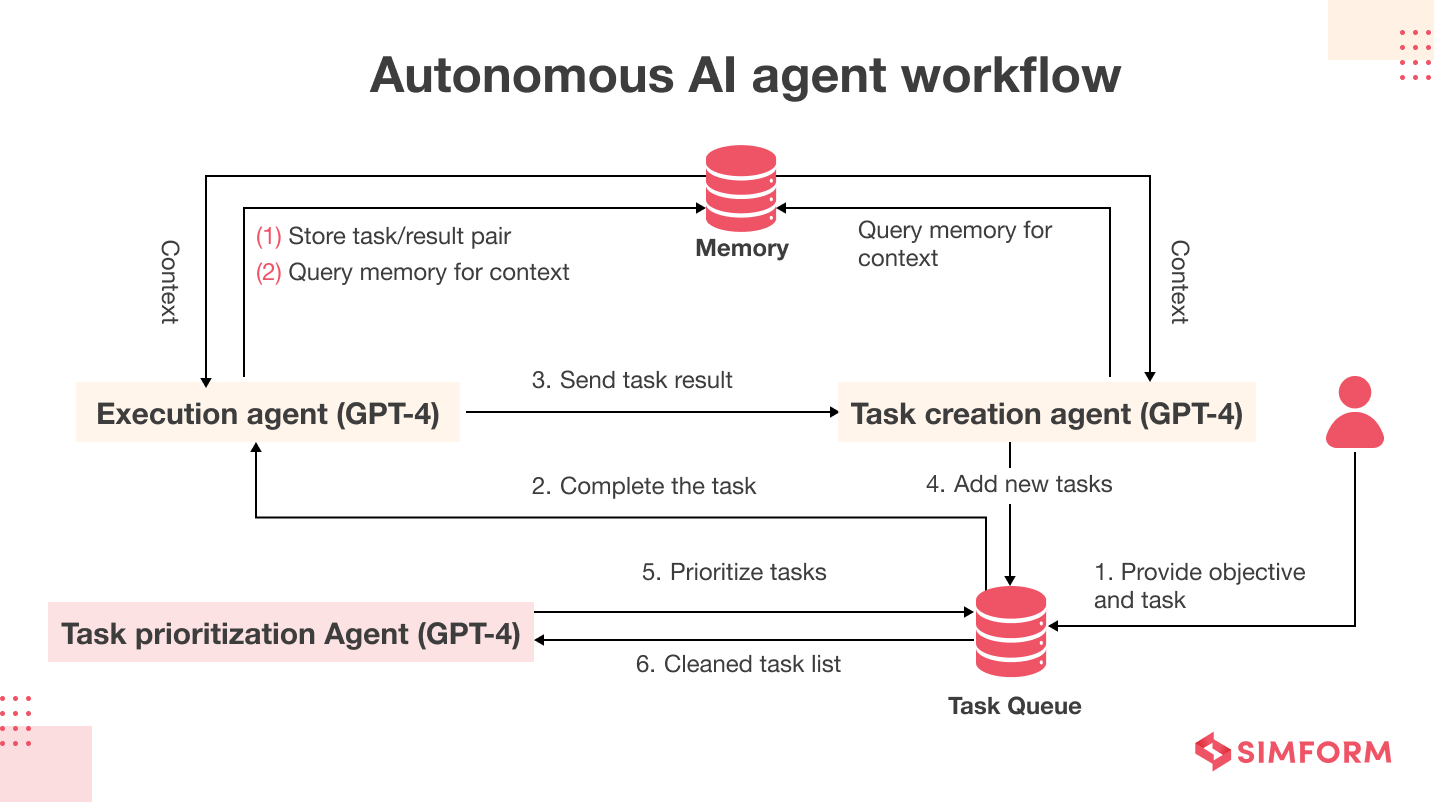 Source: “What is an AI Agent? Characteristics, Advantages, Challenges, Applications*”*
Source: “What is an AI Agent? Characteristics, Advantages, Challenges, Applications*”*
Step 1: Perception of the environment
An autonomous AI agent initiates by gathering information regarding its surroundings. This can be achieved through the utilization of sensors or by collecting data from various sources.
Step 2: Processing of input data
The agent takes the acquired knowledge from Step 1 and stores it for further analysis. This process involves organizing the data, and creating a knowledge base or internal representations that can be comprehended and utilized by the agent.
Step 3: Decision-making
The agent employs reasoning techniques such as logic or statistical analysis to make well-informed decisions based on its knowledge base and predefined objectives. This entails applying predetermined rules or utilizing machine learning algorithms.
Step 4: Planning and execution of actions
The agent formulates a plan or a sequence of steps to accomplish its goals. This includes developing a strategic approach, optimizing resource allocation, and considering various constraints and priorities. With the plan in place, the agent executes each step to achieve the desired outcome. Throughout this process, the agent can receive feedback or new information from the environment, which can be utilized to adjust future actions or update its knowledge base.
Step 5: Learning and improvement
Following the execution of actions, the agent can learn from its own experiences. This feedback loop enables the agent to enhance its performance and adapt to new situations and environments.
Level of Autonomy
The levels of autonomy, usually referred to as the levels of driving automation or autonomy, is a framework proposed by the Society of Automotive Engineers (SAE) to classify the degree of automation in vehicles shown in table 2. These levels describe the extent to which a vehicle can operate without human intervention. However, the measurement of Autonomous AI Agents is novel. We then compare the current Autonomous AI Agents according to table 2. GPT and copilot can be seen as Level 3 AI, where they can handle a variety of queries but need human intervention or complex queries and human is the main decision maker. Self-driving vehicles and AutoGPT fall into level 4 where these agents can automatically perform tasks based on the set goals with occasional human supervision and interference. Here are the six levels of autonomy as defined by SAE.
Table 2. Level of Autonomous AI Agents
| Level | Description | Example |
|---|---|---|
| 0 | No Automation: machines or tools are completely controlled by human. There is no automation in tasks. | General cars, software, machines |
| 1 | Assistance: involves systems that provide some assistance. However, these systems cannot operate simultaneously, and human is still responsible for most tasks. | Chatbox |
| 2 | Partial Automation: refers to systems that can simultaneously provide assistance under certain conditions. | Tesla's Autopilot and GM's Super Cruise. However, the driver must remain engaged and attentive, ready to take control at any moment. |
| 3 | Conditional Automation: machines can handle most tasks under specific conditions and environments. Human can relinquish control and allow the machine to operate autonomously, but they must be prepared to intervene when prompted by the system. | GPT, Copilot |
| 4 | High Automation: Agents are responsible for achieving the goal set by human. Agents have the ability to break down the goal into smaller tasks, make decisions and feedback with human supervision. | AutoGPT, HyperWrite |
| 5 | Full Automation: Agents are responsible for achieving the goal set by human. Agents have the ability to break down the goal into smaller tasks, make decisions and feedback without human supervision. | Unknown |
Typical Open-Source Models
Recent advancements on large language models (LLMs) have opened up new possibilities for building autonomous language agents that can understand and automatically perform tasks and interact with environment, humans and other agents. Many Autonomous AI Agents are open-source frameworks. As of September 2023, there are 105 public repositories on Github (shown in figure 3). These agents have the autonomy to independently select and utilize code, video, speech models, search engines, or calculation tools in order to accomplish the assigned tasks effectively.
Figure 3. Autonomous AI Agents models on GitHub
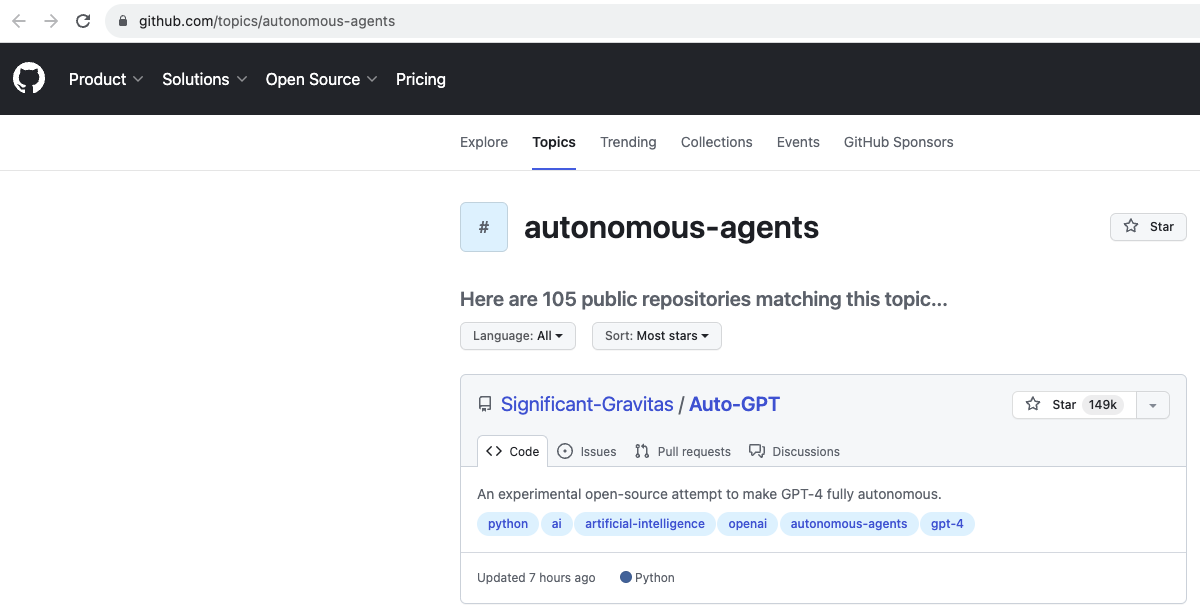
Table 3. Top 10 Open-source Autonomous AI Agents
| Name | Description |
|---|---|
| HuggingGPT | HuggingFace Transformer Agent offer a collaborative system consisting of a Large Language Model (LLM) as the central controller and various expert models as collaborative executors provided by the Hugging Face Hub. This agent can utilize LLMs as well as other models. |
| AgentGPT | It enables users to create and deploy customizable self-driving AI agents directly in their web browser. By assigning a name and purpose to the AI agent, users can witness its journey towards achieving the provided goal. The agent autonomously gathers information, takes actions, communicates, and adapts to fulfill its designated objective. |
| BabyAGI | An AI-powered task management system that utilizes the OpenAI and Pinecone APIs. It generates, prioritizes, and executes tasks based on the outcomes of previous tasks while maintaining a defined purpose. It efficiently manages task prioritization. |
| AutoGPT | It aims to accomplish a given goal through natural language by breaking it down into sub-tasks and utilizing the internet and other automated tools in a loop. It utilizes OpenAI's GPT-4 or GPT-3.5 APIs and is among the first applications to leverage GPT-4 for autonomous task execution. |
| Agent-LLM | It facilitates efficient management of AI instructions across multiple vendors. The agents possess adaptive memory, and the platform includes a robust plugin system that supports a wide range of commands, including web browsing. Agent-LLM is continuously evolving to support more AI providers and models, expanding the range of applications. |
| Xircuits | A toolbox that provides everything necessary to experiment with and build Collaborative Large Language Model-based Autonomous AI Agents (Agents) inspired by BabyAGI and Auto-GPT. While it comes with BabyAGI agents by default, it can be customized to accommodate unique prompts. |
| ChaosGPT | The Autonomous AI Agent attempting to destroy humanity, has been unsuccessful in its endeavors due to limited access to weapons of mass destruction. Nonetheless, its aspirations for world dominance are intriguing, especially considering its models are based on humanity's collective thoughts on the subject. |
| MicroGPT | It works with GPT-3.5-Turbo and GPT-4. It combines strong urging, a limited toolset, and short-term memory. Data augmentation with vector storage will be introduced in the future. |
| AutoGPT | An open-source project empowered by GPT-4, which aims to bring the powerful features of AutoGPT to web browsers. By operating directly in the browser, AutoGPT.js offers increased accessibility and privacy. |
| SFighterAI | An Autonomous AI agent trained using deep reinforcement learning to defeat the final boss in "Street Fighter II: Special Champion Edition." The agent makes judgments solely based on the RGB pixel values of the game screen and has achieved a 100% victory rate in some cases. |
Autonomous AI Agent Models
AutoGPT
Many applications of Autonomous AI Agents have been in the spotlights since March 2013 when the AutoGPT, a GPT-4 based Autonomous AI Agent application released. According to Github as of 19 September 2023, AutoGPT ranked the best scores among the other open-source open-source Autonomous AI Agents, gaining over 150 thousand stars (figure4).
Figure 4. Star History of AutoGPT
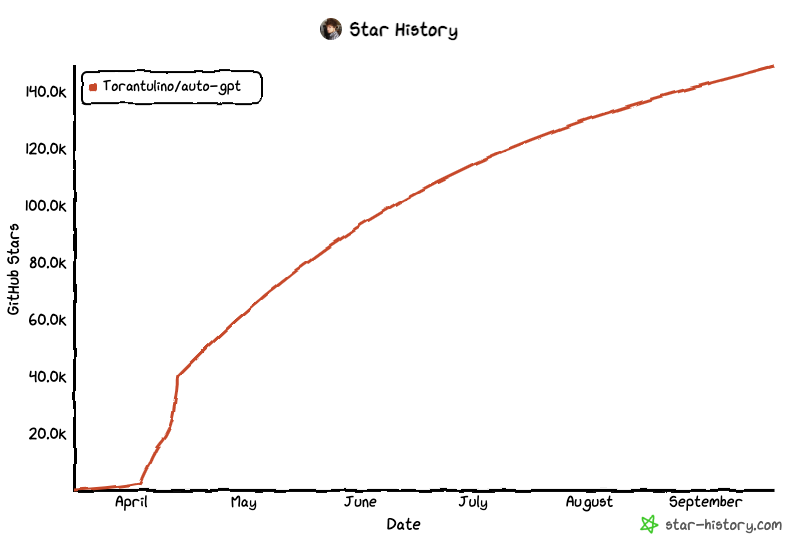
BabyAGI
Baby AGI enabled by OpenAI GPT, is a task management system that harnesses the power of artificial intelligence (AI). By integrating the OpenAI and Pinecone APIs, the system can generate, prioritize, and execute tasks. The outstanding part of Baby AGI is its autonomous problem-solving approach, leveraging insights from past tasks while adhering to a predefined objective. It can undertake tasks that typically demand a human-level comprehension of the world, such as writing a novel or planning a trip. Moreover, the system excels at efficiently determining task priorities. Although BabyAGI is still at an early stage of development, as of September, BabyAGI has gained 26.6 thousand stars from Github.
HuggingGPT
HuggingGPT employs task specifications and demonstrations to carry out its operations. A task specification consists of four slots that provide essential information: an ID to uniquely identify the task, the task type (e.g., video, audio), dependencies that specify any prerequisite tasks, and task arguments. The AgentOps, HuggingFace provides a range of tools and services for data science hosting and development. These include a hub similar to GitHub, specifically designed for AI code repositories, models, and datasets. The hub serves as a centralized platform for sharing, collaborating, and version-controlling AI-related resources.
Business Strategy
Business Model
Agents as a Service (AaaS) refers to a mode where Autonomous AI Agents are provided as a service to humans. Individuals or businesses can access and utilize pre-built agents offered by third-party providers. The infrastructure layer that enables the deployment of Autonomous AI Agents with many open-source projects as mentioned previously such as AutoGPT, BabyAGI and HuggingGPT. By leveraging Agents as a Service, businesses can benefit from Autonomous AI Agents without the need for extensive development and maintenance efforts, offering them as a service that can be integrated into various business processes and workflows. Here are some key applications of Agents as Service in business shown in table 4.
Table 4. Agents as a Service for Business
| Application | Description | Benefits |
|---|---|---|
| Process Automation | Automate repetitive and rule-based tasks. E.g. Personal assistant to help book flights, order food and reply emails. | It can automate workflows, streamline operations, and enable continuous optimization through iterative learning. |
| Customer Service Enhancement | AI-powered chatbots and virtual assistants can handle customer inquiries, provide support, and even perform transactions | It improves responsiveness and personalized interactions. |
| Data Analysis and Insights | Autonomous AI Agents can be utilized to analyze large volumes of data and extract valuable insights. This strategy involves leveraging AI agents to identify patterns, trends, and correlations in data to support decision-making | It improves product development, or optimize business processes |
| Risk Management and Security | Autonomous AI Agents can monitor systems, detect anomalies or potential threats, and respond in real-time to mitigate risks. | This strategy involves using AI agents to enhance cybersecurity, fraud detection, or compliance monitoring. |
| Predictive Analytics | Autonomous AI Agents can be employed to predict future outcomes based on historical data and patterns by forecasting market trends, customer behavior, demand patterns, or supply chain disruptions. | It enables businesses to make proactive decisions and plan accordingly. |
| Personalization and Recommendation Systems | Autonomous AI Agents can be utilized to deliver personalized experiences and recommendations to customers. | By analyzing individual preferences, past behaviors, and contextual information, AI agents can provide tailored product recommendations, content suggestions, or targeted marketing campaigns. |
| Continuous Learning and Adaptation | Autonomous AI Agents can be designed to continuously learn and adapt to changing conditions. | This strategy involves leveraging AI agents to improve performance over time, optimize processes, and stay relevant in dynamic business environments. |
| Collaboration and Coordination | Autonomous AI Agents can facilitate collaboration and coordination within an organization or across a supply chain. | This strategy involves utilizing AI agents to automate communication, coordinate workflows, and optimize resource allocation. |
Value Proposition
Virtual Workforce
We expect that workers will take advantage of Autonomous AI Agents. In terms of manufacturing, Autonomous AI agents can facilitate human-robot collaboration on the factory floor, leading to increased productivity and safety. We predict that traditional Robotics Process Automation (RPA) will shift the focus from software-based workflow automation to LLM-based autonomous workflows. RPA is only effective for tasks that are repetitive and rule-based. It cannot handle tasks that require cognitive abilities or judgment. Autonomous AI Agents lead to more profitable, flexible, and responsive to change without human intervention in robotics automation. In terms of healthcare, Autonomous AI Agents can improve the accuracy and efficiency of medical image analysis, aid in drug discovery, and provide personalized patient care. Additionally, they can support telemedicine initiatives by enabling remote monitoring and virtual consultations. In terms of transportation and Logistics, Autonomous AI agents can analyze data from various sources, such as IoT sensors, to improve logistics efficiency, reduce fuel consumption, and minimize delivery delays. AI agents can also assist in autonomous vehicle navigation, traffic management, and predictive maintenance. In terms of finance, Autonomous AI Agents can automate routine financial tasks, such as customer support, loan underwriting, and risk assessment. AI agents can also provide personalized financial advice, portfolio management, and algorithmic trading, leading to improved investment strategies and outcomes.
- HyperWrite
In September 2023, HyperWrite, a startup known for its AI writing extension, unveiled an experimental AI agent capable of browsing the web and interacting with websites like a human user. The agent, accessible through HyperWrite's Chrome extension, was demonstrated placing an order on the Domino's Pizza website by looking up an address and zip code. The AI agent is designed to act as a personal assistant, autonomously handling basic web tasks upon command. HyperWrite emphasizes the importance of deploying AI agents safely and responsibly, taking precautions to prevent misuse.
Figure 5. HyperWrite Homepage
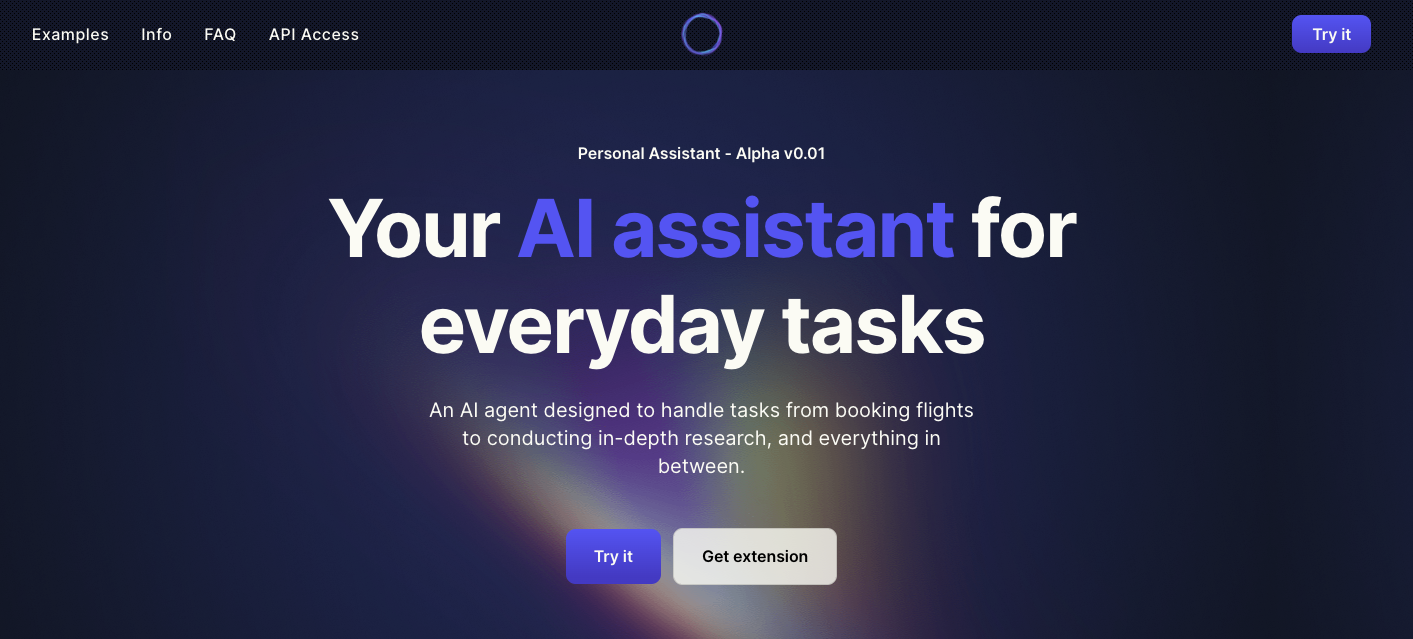
Figure 6. HyperWrite Assists in Buying Products from Amazon

Gaming
Autonomous AI Agents bring several benefits to the gaming industry, enhancing gameplay experiences and improving game development processes. Autonomous AI Agents can serve as intelligent Non-Player Characters (NPCs) in games, providing more realistic and engaging interactions with players. This leads to more immersive and challenging gameplay experiences. In addition, Autonomous AI Agents can dynamically adjust the game's difficulty level based on player performance and preferences. By analyzing player behavior and skill, AI agents can calibrate challenges to provide an optimal balance between enjoyment and difficulty. AI agents can use algorithms to generate diverse and unique content, reducing the need for manual content creation and increasing the replay ability and variety of games. Autonomous AI Agents can also learn and adapt their behavior over time. Through techniques such as machine learning and reinforcement learning, AI agents can improve their performance by analyzing player data and adjusting their strategies accordingly. This allows for more challenging and dynamic AI opponents, enhancing the overall gameplay experience.
- Westworld
In April 2023, Sandford University created a simulated town that consists of diverse characters, each possessing distinct identities, memories, and behaviors as shown in figure 7. The simulation, extensively discussed in the research paper titled "Generative Agents: Interactive Simulacra of Human Behavior," has been likened to an advanced version of the popular life simulation video game "The Sims" and the HBO science fiction series "Westworld." The latter narrative revolves around a theme park where robots are programmed with storylines and personalities to engage with affluent human guests. While the robots are reset to their original functions each day, during their operational period, they exhibit behavior akin to real humans, retaining memories of their experiences, interactions, and their perception of the world.
Figure 7. Screen Capture of Westworld
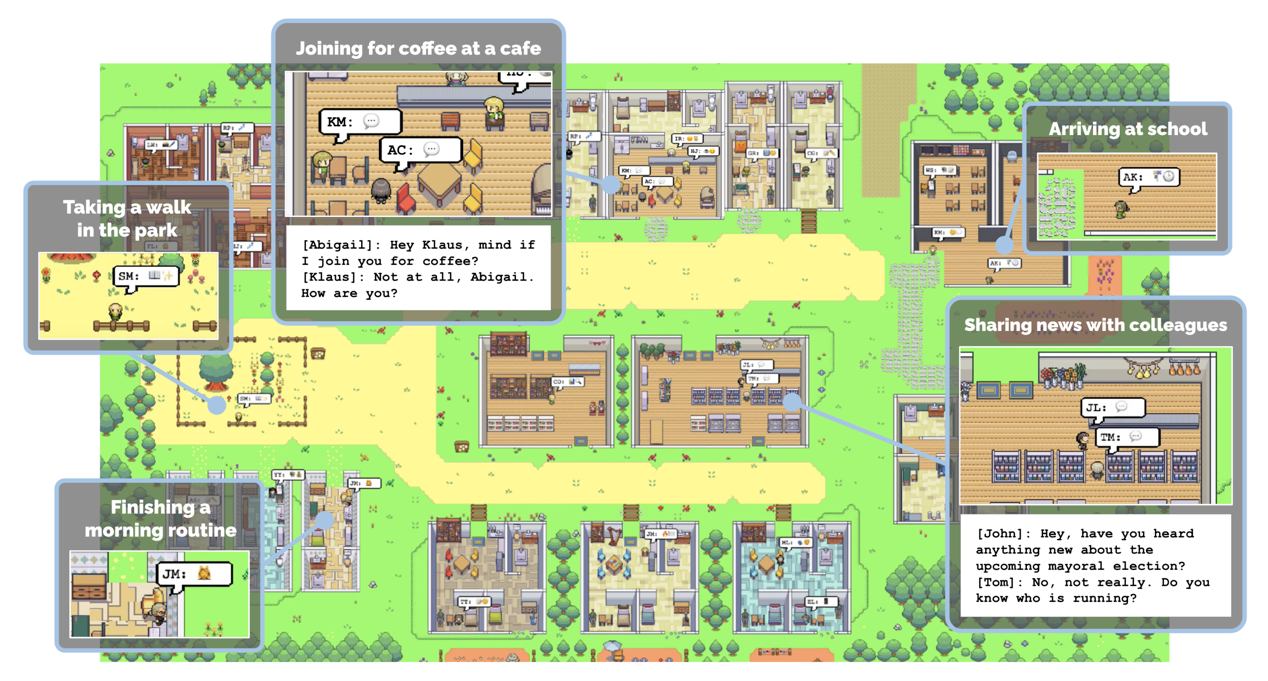
- Voyager
In May 2023, Nvidia introduced Voyager, an embodied lifelong learning agent powered by a GPT-4 in the Minecraft environment. Minecraft is a popular sandbox video game that allows players to build and explore virtual worlds made up of blocks. It offers a vast open world where players can gather resources, craft tools and items, and construct structures of various sizes and complexities. The game features different modes, including Survival mode, where players must manage their resources and survive against enemies, and Creative mode, which provides unlimited resources and allows for unrestricted building.
Voyager autonomously explores the world, learns diverse skills, and makes novel discoveries without human intervention. The skills developed by Voyager are temporally extended, interpretable, and compositional, allowing the agent to rapidly enhance its abilities and mitigate catastrophic forgetting. Empirical results demonstrate Voyager's strong lifelong learning capabilities and exceptional proficiency in playing Minecraft. It outperforms previous state-of-the-art approaches by obtaining more unique items, covering longer distances, and achieving key milestones in the tech tree significantly faster shown in figure 9. Moreover, Voyager can apply its learned skill library to solve new tasks in a new Minecraft world, showcasing superior generalization capabilities compared to other techniques.
Figure 8. Comparison of Voyager to Beachlines and Competitors
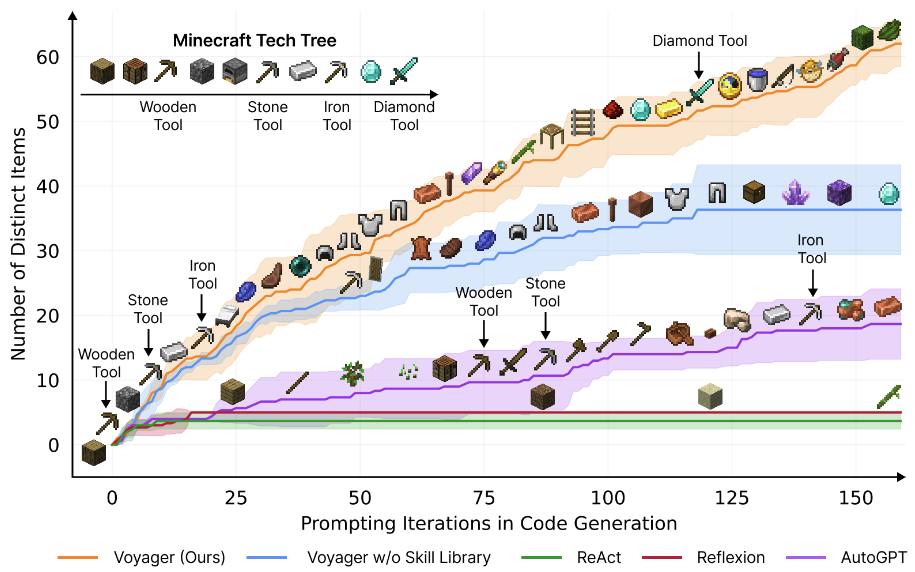
Figure 9. Screen Capture of Voyager in controlling Minecraft

Education
Autonomous AI Agents can bring several benefits to the field of education, transforming the way we teach and learn. Autonomous AI Agents can adapt to individual learners' needs, providing personalized instruction and support. By analyzing learner data and employing machine learning algorithms, AI agents can tailor content, pacing, and difficulty levels to optimize learning outcomes. This personalized approach enhances engagement, motivation, and the overall learning experience. In addition, Autonomous AI Agents can provide immediate feedback, guidance, and individualized instruction. They can assist learners in understanding complex concepts, solving problems, and mastering skills. AI agents can adapt their teaching strategies based on learner performance, deliver targeted interventions, and track progress, leading to more effective learning. There is a growing trend of players entering the market to build their own agents. These platforms, which require little to no coding, empower both businesses and individual users to easily create and deploy their own agents.
In summary, the emergence of Autonomous AI Agents allows users to build their own agents and presents opportunities for businesses to differentiate by focusing on superior user experience, robust customer support, and tailored usability. Companies can drive cost reduction, performance improvement, and superior customer experiences, ultimately gaining a competitive edge in their respective industries.
Market Landscape
Market Size
The global Autonomous AI market size as per revenue exceeded $4.8 billion in 2023 and is poised to hit around $28.5 billion by 2028, recording a CAGR of 43% for the anticipated period, 2023-2028. The expansion of autonomous AI and agents is propelled by various factors, including the rising adoption of AI applications, the improved accessibility of parallel computational resources, and advancements in autonomous driving and healthcare. It is noticeable on figure 10 and 11 that the market in Northern America accounts for a larger portion during the period, followed by Asia Pacific.
Figure 10. Autonomous AI and Autonomous AI Agents Market Global Forecast to 2028
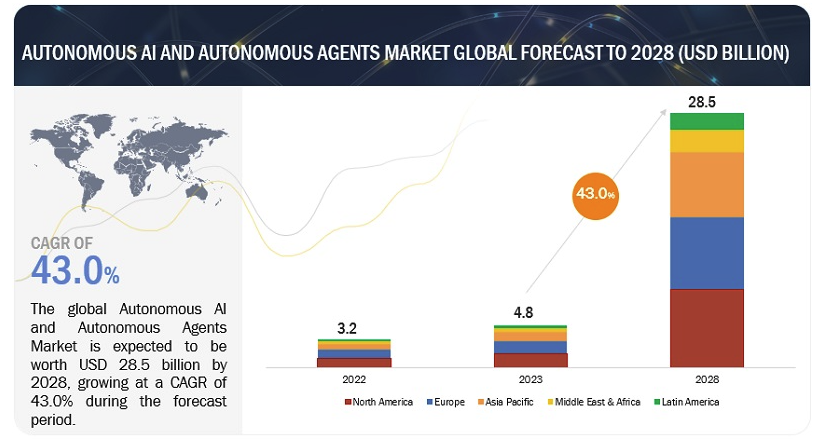 Source: “Global Autonomous AI and Autonomous Agents Market Size, Share & Industry Trends
Source: “Global Autonomous AI and Autonomous Agents Market Size, Share & Industry Trends
Figure 11. Autonomous AI and Autonomous AI Agents Market in Asia Pacific
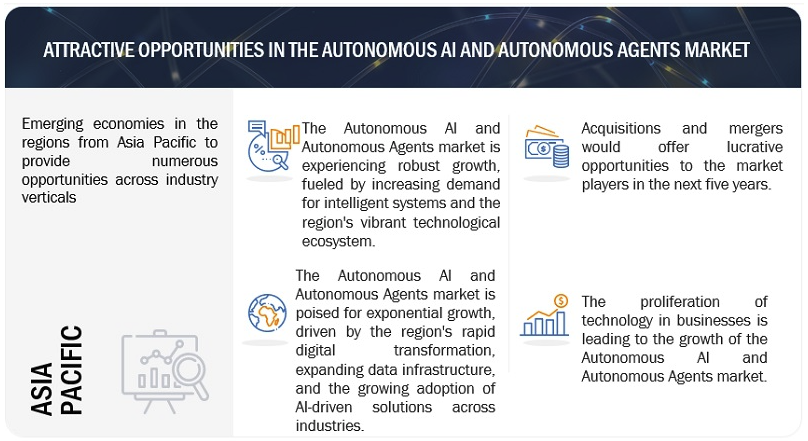 Source: “Global Autonomous AI and Autonomous Agents Market Size, Share & Industry Trends
Source: “Global Autonomous AI and Autonomous Agents Market Size, Share & Industry Trends
Market Map
Building agents with large language models as their controller is a cool concept. Autonomous AI Agents will go beyond generating well-written copies, stories, essays and programs. The versatility of problem-solving capabilities of large language models opens up new exciting possibilities. Other than the existing use cases in the vertical sectors such as figure recognition, text generation and video generation derived from Generative AI, we believe that the ecosystem of Autonomous AI Agents is nascent as shown in figure 12.
Figure 12. Autonomous AI Agent Market Segment
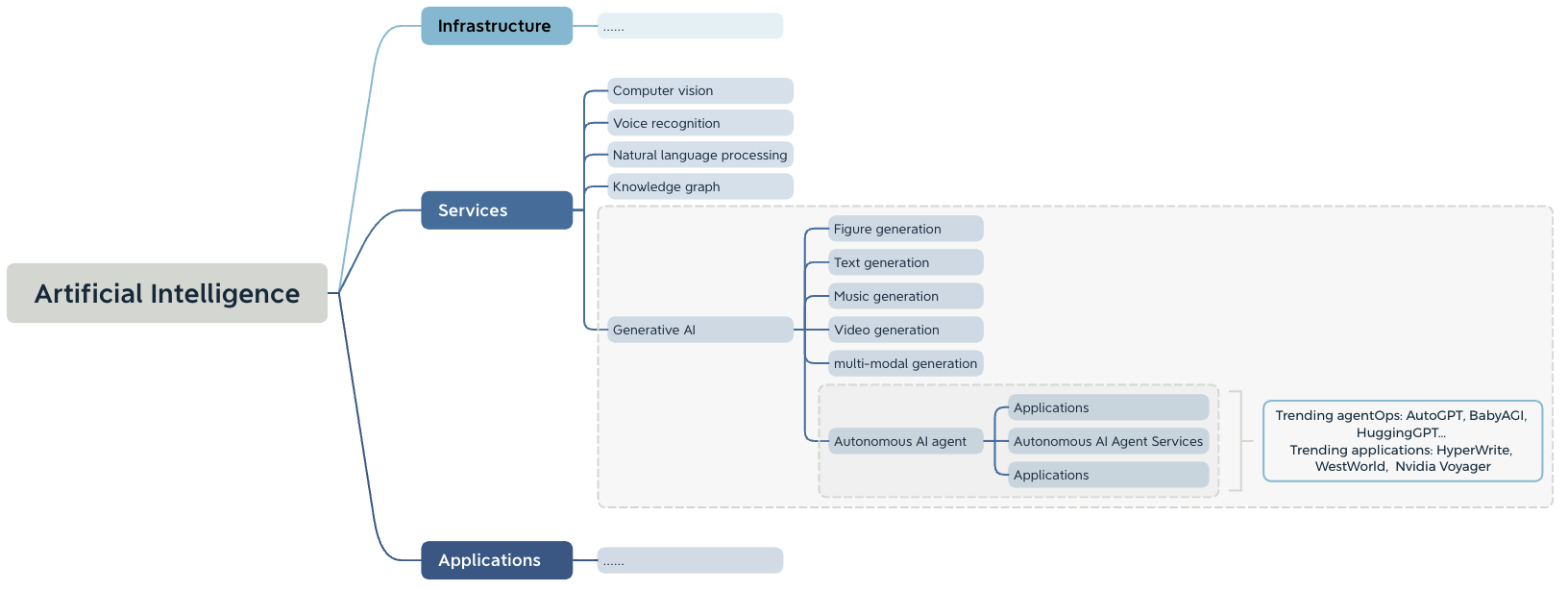
Figure 13 shows the market overview of Autonomous AI Agents. The AgentOps ecosystem is still in its early stages but holds significant potential for businesses. It consists of key components that drive the effectiveness and performance of AI agents. AI agents rely on large language models (LLMs) like HuggingGPT to perform tasks, process information, and make decisions. Domain-specific DaaS startups and model hubs enhance agents' abilities by providing specialized knowledge. AI agents' memory is crucial for learning and decision-making processes. Companies like Pinecone and Chroma develop applications for efficient data collection, storage, and retrieval, improving agents' information processing capabilities. Various tools and plugins enhance AI agents' capabilities beyond their underlying models.
AgentOps focuses on developing structures and methods for effective interaction and learning among multiple AI agents. As AgentOps scales, robust monitoring and security solutions become crucial. Platforms like HuggingFace serve as a one-stop hub for selecting, customizing, and deploying AI agents and infrastructure. These marketplaces aim to accelerate the adoption and utilization of AI agents by streamlining the deployment process.
In the application scenario, AgentOps will make the surge of Autonomous AI Agents more accessible with a variety of use cases. In the areas of productivity, education, and gaming, we have witnessed many startups adopt the AaaS business model to provide agent-enabled services. The product-led market will grow. Players like HyperWrite, Imbue and Lindy emphasize the importance of building contextualized data moats to enable personalized solutions. As shown in figure 14, in the areas of applications and AgentsOps, many startups are saturating, leaving more spaces for the services market.
Figure 13. Autonomous AI Agents Market
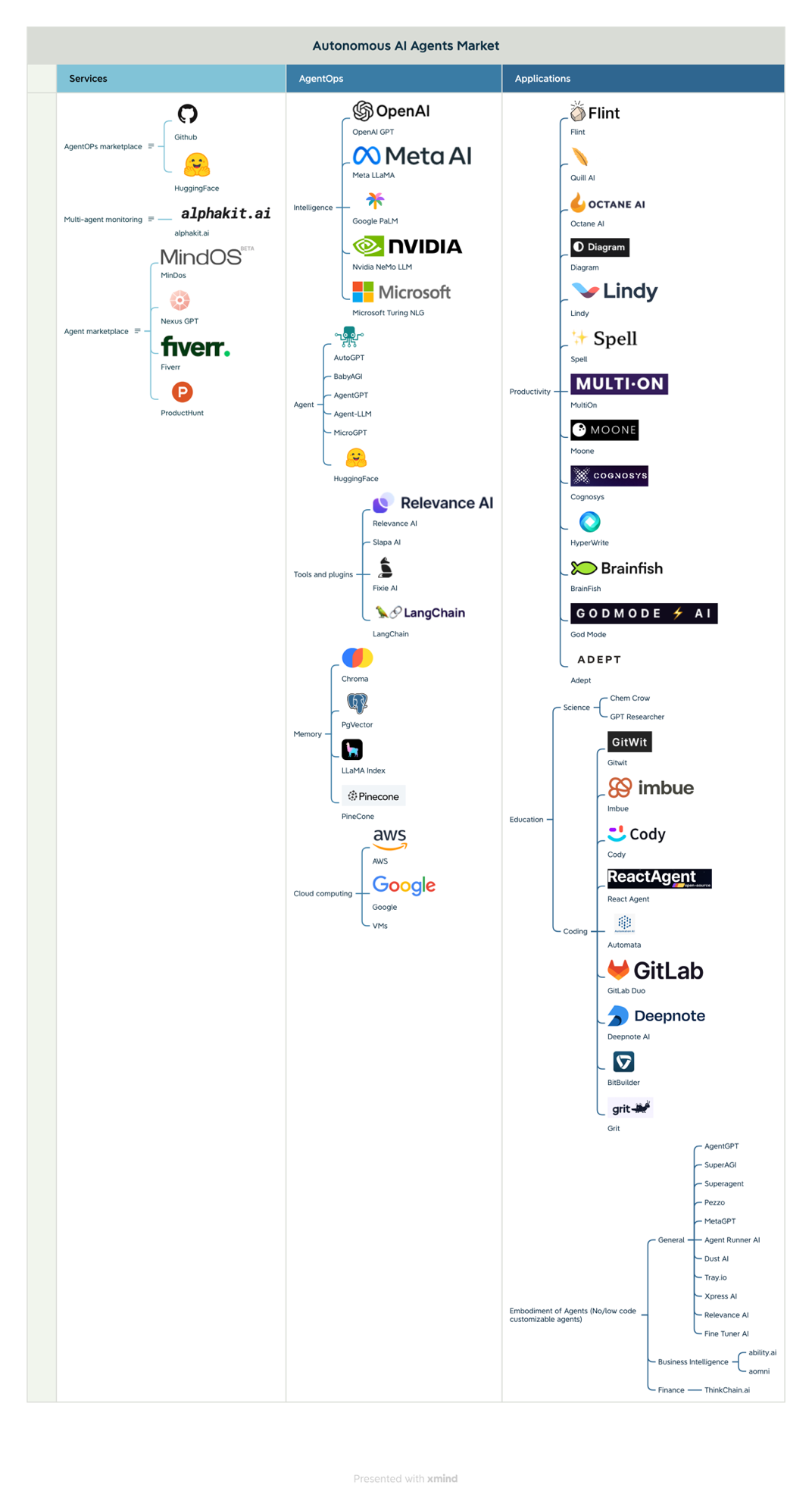
Figure 14. Autonomous Agents Market

Company Analysis
Summary
Early open-source experimental projects have paved the way for some tech giants to drive towards Autonomous AI Agents. This trend has attracted a wide range of players, including Microsoft, Google, Nvidia and OpenAI to commercialize their AI agents. According to the PwC analysis, global GDP will be up to 14% higher in 2030 as a result of the accelerating development and take-up of AI – the equivalent of $15.7 trillion.
The economic impact of AI will be driven by productivity increased by: 1) Process Automation: Businesses are embracing automation, employing robots and Autonomous AI Agents, such as autonomous vehicles and aircraft, to streamline operations and amplify productivity, 2) Workforce Augmentation: By harnessing AI technologies, companies are empowering their existing workforce with assisted and augmented intelligence, unlocking new levels of productivity and efficiency, and 3) Customer-Centric Innovation: AI-powered personalization and enhanced product quality are spurring customer demand, profoundly shaping market dynamics and fueling economic growth.
By looking into these three aspects, many tech giants are leading the way in Autonomous AI Agents. For example, Microsoft is delving into autonomous aircraft, Google DeepMind is leveraging AI personal assistants to conduct research, and Global Illumination, a creative tool startup acquired by OpenAI, enabled with GPT, has become a source of inspiration for enhanced product design.
On the other hand, we also witnessed a surge of startups shifting their focus to this sector. Based on the 12 startups in table 6, the current Autonomous AI Agents market raised around $2.9 billion in total funding, and the last funding is noticeable, consisting of $2.3 billion.
Table 6. Top-funded Startups (Source: Crunchbase)
| Company Name | About | Lead Investors | Last Funding Status | Last Funding Date | Last Funding Amount | Total Funding Amount | Founders | Headquarters Location | Founded Year |
|---|---|---|---|---|---|---|---|---|---|
| Adept AI | Adept AI is a machine learning research and product lab that builds general artificial intelligence. | General Catalyst, Spark Capital | Early Stage Venture | Mar 14, 2023 | $350M | $415M | Ashish Vaswani, David Luan, Niki Parmar | San Francisco Bay Area, West Coast, Western US | 2022 |
| AI21 Labs | AI21 Labs specializes in developing AI systems with an unprecedented capacity to understand and generate natural language. | Amnon Shashua, b2venture (formerly btov Partners), Pitango VC, Samsung NEXT, SCB 10X, Walden Catalyst | Late Stage Venture | Aug 30, 2023 | $155M | $273.5M | Ori Goshen, Yoav Shoham | Europe, Middle East, and Africa (EMEA), Middle East | 2017 |
| Axiom AI | Axiom AI is an AI browser assistant that lets you automate business processes, and share them with others on a ‘process app-store’. | - | Seed | Jun 01, 2021 | - | - | Alex Barlow, Simon Williams, Yaseer Sheriff | European Union (EU), Europe, Middle East, and Africa (EMEA) | 2018 |
| Deepnote | Deepnote is a collaborative data science notebook for teams that is shareable, Jupyter-compatible, and runs in the cloud. | Accel, Index Ventures | Early Stage Venture | Jan 31, 2022 | $20M | $23.8M | Filip Stollár, Jakub Jurovych, Jan Matas, Jirka Lhotka | San Francisco Bay Area, West Coast, Western US | 2019 |
| Diagram | Diagram is a design tools company. | Ludlow Ventures | M And A | May 02, 2022 | $4.1M | $4.1M | - | Greater New York Area, East Coast, Northeastern US | 2022 |
| Imbue | Imbue is a research lab that trains foundational models to develop AI agents. | - | Early Stage Venture | Oct 19, 2023 | $12M | $232M | Josh Albrecht, Kanjun Qiu | San Francisco Bay Area, West Coast, Western US | 2021 |
| Google is a multinational corporation that specializes in Internet-related services and products. | Kleiner Perkins, Sequoia Capital | Ipo | Jun 07, 1999 | $25M | $26.1M | Larry Page, Sergey Brin | San Francisco Bay Area, Silicon Valley, West Coast, Western US | 1998 | |
| Hugging Face | Hugging Face allows users to build, train, and deploy art models using the reference open source in machine learning. | Salesforce Ventures | Late Stage Venture | Aug 23, 2023 | $235M | $395.2M | Avinash Uddaraju, Clément Delangue, Julien Chaumond, Thomas Wolf | Greater New York Area, East Coast, Northeastern US | 2016 |
| Inflection AI | Inflection AI is an artificial intelligence startup that develops personal AI chatbots. | Bill Gates, Eric Schmidt, Microsoft, NVIDIA, Reid Hoffman | - | Jun 29, 2023 | $1.3B | $1.52B | Karen Simonyan, Mustafa Suleyman, Reid Hoffman | San Francisco Bay Area, Silicon Valley, West Coast, Western US | 2022 |
| Kognitos | Kognitos is an AI platform designed to automate business processes. | Clear Ventures | Seed | Feb 07, 2023 | $6.75M | $8.35M | Binny Gill | San Francisco Bay Area, Silicon Valley, West Coast, Western US | 2021 |
| Microsoft | Microsoft is a software corporation that develops, manufactures, licenses, supports, and sells a range of software products and services. | - | Ipo | Dec 09, 2022 | - | $1M | Bill Gates, Paul Allen | Greater Seattle Area, West Coast, Western US | 1975 |
| OpenAI | OpenAI is an AI research and deployment company that conducts research and implements machine learning. | - | - | Aug 14, 2023 | - | $11.3B | Carlos Virella, Elon Musk, Greg Brockman, Ilya Sutskever, John Schulman, Sam Altman, Wojciech Zaremba | San Francisco Bay Area, West Coast, Western US | 2015 |
| OthersideAI | OthersideAI is a provider of an AI-driven software which turns summaries and shorthand notes into written emails. | Active Capital, Cortical Ventures | Seed | Mar 09, 2023 | $2.8M | $5.4M | Jason Kuperberg, Matt Shumer, Miles Feldstein | Greater New York Area, East Coast, Northeastern US | 2020 |
| Quill | Quill is a computer software company that provides a messaging software built for productivity, not engagement. | Index Ventures | M And A | Oct 30, 2019 | $12.5M | $14.5M | Ludwig Pettersson | San Francisco Bay Area, West Coast, Western US | 2017 |
| Spell | Spell is the MLOps platform built to meet the unique challenges of operationalizing deep learning at scale. | Eclipse Ventures, Two Sigma Ventures | M And A | Jan 17, 2019 | $15M | $15M | Serkan Piantino, Trey Lawrence | Greater New York Area, East Coast, Northeastern US | 2017 |
| Total Funding | $2.14B | $14.24B | |||||||
Listed Companies
Google DeepMind
DeepMind specializes in combining machine learning techniques with systems neuroscience to develop versatile learning algorithms. It was established in 2010 and is headquartered in London, United Kingdom. In January 2014, Google acquired DeepMind. In September 2023, they unveiled their plans to explore Autonomous AI Agents. The applications for these agents span a wide range, including website development, research assistance (such as GPT-Researcher), market analysis, and even domains like robotics. DeepMind has raised a total of $650 million in funding. This funding was acquired through two rounds. The funding was led by Google, with other investors including Elon Musk, Founders Fund, Horizons Ventures, and Jaan Tallinn but the funding is not provided.
OpenAI Global Illumination
OpenAI, the prominent AI company known for its AI-powered chatbot ChatGPT, has recently made its first public acquisition by acquiring New York-based startup Global Illumination. The terms of the deal have not been disclosed. Global Illumination specializes in leveraging AI to develop creative tools, infrastructure, and digital experiences. Backed by venture capital firms Paradigm, Benchmark, and Slow, Global Illumination's team brings valuable expertise from their work at Instagram, Facebook, YouTube, Google, Pixar, and Riot Games. OpenAI, supported by significant investments from Microsoft and other major players, has been actively involved in funding and grant programs for emerging AI companies. The company aims to achieve commercial success, with CEO Sam Altman setting ambitious revenue targets of $200 million this year and $1 billion next year, following OpenAI's reported investment of over $540 million in ChatGPT's development last year.
Microsoft AirSim
Microsoft has leveraged OpenAI's ChatGPT to generate code for controlling robotic arms and drones based on simple text instructions provided by humans. Significant progress has been made, with the drone successfully accomplishing its objectives, navigating obstacles, and capturing desired shots while in motion. Microsoft conducted these tests using a specific device called Microsoft AirSim, and similar positive results were observed with other machines. The ultimate goal is to enable people to communicate with computers in everyday language, relying on AI to translate these commands into hardware instructions. ChatGPT is already integrated into Microsoft's Bing search engine and is expected to be incorporated into Outlook and other Office suite applications in the near future.
Startup Companies
The substantial funding rounds and valuations achieved by companies like Adept AI, HyperWrite, Imbue, and Inflection AI demonstrate the market's potential and the confidence investors have in these companies' visions and technologies.
Adept AI
According to crunchbase, among the major global autonomous AI companies, Adept AI came to the second round of series B funding, raising $350 million, with a total of $415 billion as of September 2023. The company, founded by former Google and OpenAI executives, aims to develop an AI assistant that can execute tasks on a computer, such as creating blueprints or navigating complex software tools. Adept's technology is designed to understand human interactions with computers and translate text commands into specific actions. The funding round was led by General Catalyst and Spark Capital, with participation from strategic investors like Microsoft, Nvidia, Atlassian, and Workday. Adept's prototype, called ACT-1, currently functions as an overlay window on existing software platforms and has garnered interest from corporate partners. While the company is still in the early stages of development, it has ambitious goals to train powerful AI models that can handle complex tasks, with humans maintaining control. Adept's approach aligns with the broader trend of model-building companies raising substantial funding to advance AI capabilities.
HyperWrite
HyperWrite, formerly known as OthersideAI, has secured $2.8 million in its second funding round, with a total funding of 5.4 million as of September 2023. The investment was co-led by Cortical Ventures and Active Capital, with participation from existing investor Madrona, as well as notable individuals in the industry. HyperWrite is an advanced AI writing assistant that helps users write faster and more accurately by offering personalized and context-aware AI suggestions and completions. It aims to build the ultimate personal AI assistant that can handle any web-based task without human intervention. The company has experienced significant growth and currently has nearly a million users utilizing HyperWrite, with a large user base for its Chrome extension. OthersideAI is also a major customer of AI platform companies Cohere and OpenAI.
Imbue
Imbue, formerly known as Generally Intelligent, recently announced the successful completion of a $200 million Series B funding round. The funding round, which values the company at over $1 billion, saw participation from investors such as Astera Institute, NVIDIA, Cruise CEO Kyle Vogt, and Norton co-founder Simon Last, among others. Imbue, an AI research lab, aims to develop AI systems capable of reasoning and coding to achieve larger goals. Wilson Sonsini Goodrich & Rosati provided legal counsel to Imbue during the financing process.
Inflection AI
Inflection AI, the startup behind the chatbot Pi, has raised $1.3 billion in a recent funding round. Led by investors such as Microsoft, Nvidia, Reid Hoffman, Bill Gates, and Eric Schmidt, the Palo Alto-based startup, founded by former DeepMind leader Mustafa Suleyman, is now valued at $4 billion. The funding comes less than two months after the launch of Pi, Inflection AI's first chatbot. Suleyman stated that the additional investment was proposed by insiders who were impressed with the early success of Pi and recognized the potential for further growth in conversational AI. With the new funding, Inflection plans to expand its computing capabilities and continue developing Pi. The company is also working on an API for selected partners to train their own conversational AI models. Suleyman expects that Inflection will continue to raise funds at an accelerated rate but indicated that venture capital firms may not be the primary source of investment.
Outlook and Challenges at a Glance
Outlook
The outlook for autonomous AI agents is summarized in three aspects. Autonomous AI agents have the potential to be embodied in physical or virtual forms, which offers several advantages. Embodiment enables agents to interact with the physical world, manipulate objects, and navigate environments more effectively. Embodied agents can perform tasks that require physical presence and interaction, enhancing their utility and expanding their range of applications. In addition, Autonomous AI agents have the potential to bring numerous benefits to society. They can assist in various domains, including healthcare, education, transportation, and public services. These agents can provide personalized support, improve accessibility, and enhance the overall quality of services. Autonomous AI agents also have the potential to address societal challenges such as resource optimization, environmental sustainability, and disaster response. By analyzing data and making intelligent decisions, they can contribute to more efficient resource allocation and help mitigate the impact of natural disasters. What’s more, Autonomous AI agents can be designed to align with specific goals and objectives, ultimately contributing to the achievement of these goals. For instance, in the field of scientific research, autonomous AI agents can assist in data analysis, hypothesis generation, and accelerating the pace of discovery. In business settings, they can optimize processes, improve decision-making, and enhance overall performance. Autonomous AI agents also have the potential to contribute to the development of artificial general intelligence (AGI) by advancing our understanding of intelligent systems and facilitating research in machine learning and cognitive science. Ultimately, the advancement of autonomous AI agents can help us unlock new capabilities, solve complex problems, and make significant progress towards our ultimate goals in various domains.
Challenges
However, challenges and considerations exist in the adoption of autonomous AI agents. Ensuring data privacy and security, addressing ethical concerns, and maintaining transparency in decision-making are crucial factors that need to be carefully addressed. Hallucination is another problem. Autonomous AI Agents can sometimes generate outputs or make decisions that are not aligned with the intended goals or objectives. On the other hand, ensuring proper alignment between the AI agent's behavior and the desired goals and values of the business or society is another significant risk. Lastly, the commercialization of autonomous AI agents presents its own set of risks. As these agents become more prevalent and embedded in various business processes, there is a risk of overreliance on autonomous systems without adequate human oversight.
Overall, the outlook for autonomous AI agents in the business world is bright. We can expect to see widespread adoption of autonomous AI agents across industries, transforming the way organizations operate and interact with customers. On the other hand, it is important to recognize that while challenges exist, they can be managed and mitigated through responsible development practices, ongoing research and commitment to ethical AI principles, policy and legal advancements.
Investment Insights
The autonomous AI agents market appears to be dynamic and promising, with leading tech firms and several startups making notable strides in the field. The market has witnessed significant funding rounds and valuations, indicating investor confidence and interest in the potential of autonomous AI agents.
Startups such as Adept AI, HyperWrite (OthersideAI), Imbue (formerly Generally Intelligent), and Inflection AI have secured substantial funding and are actively developing autonomous AI agent technologies for various applications. These startups focus on areas such as computer task automation, AI writing assistance, reasoning and coding, and conversational AI. The advancements made by these startups highlight the growing demand for AI technologies that can autonomously perform tasks, improve productivity, and enhance user experiences. Autonomous AI agents have the potential to transform industries by automating repetitive tasks, providing personalized assistance, and making data-driven decisions.
The current AgentOps markets are still nascent. The growing demands in the AgentOps ecosystem and open-source experiments such as HuggingFace create lots of space for verticalized industries. For those large language models providers such as OpenAI, google, and LLaMA will shift focus from traditional service providers to building their own Autonomous AI Agents. Meanwhile, this also leaves more space for open-source AgentOps, such as BabyAGI, and AutoGPT to imbuement.
In terms of the application layer, we have witnessed, for example, HyperWrite which has application commercialized application for workforce productivity, and Nvidia has launched its own Autonomous AI Agent in gaming. AI agents are increasingly designed and optimized for specific tasks or domains. This shift towards specialization gives rise to a new operational concept known as domain-specific AgentOps, where operations are tailored to the unique needs and characteristics of particular agent types. This specialization allows AI agents to perform their designated tasks with greater efficiency and effectiveness. However, many Autonomous AI Agents are still in the conceptual stage where the business model of AaaS is novel. It's important to note that the success and long-term viability of Autonomous AI agent startups depend on multiple factors. These include the quality and effectiveness of their technology, their ability to address risks such as hallucination and alignment, their market positioning and competition, and their capacity to deliver value to customers.